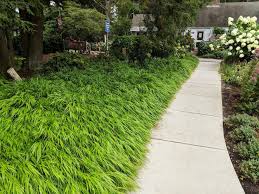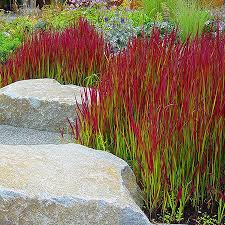Japanese Grass, also known as Zoysia japonica, is a really interesting kind of grass that many people love to have in their gardens and parks. This type of grass is famous for being tough and strong, which means it can survive in lots of different places.
You might see Japanese Grass in places like parks, lawns, and even places where people play sports. That’s because this grass can handle a lot of things. It doesn’t mind if it doesn’t rain for a while, and it can even handle people walking or running on it a lot.
What’s really cool about Japanese Grass is how it looks. It’s a beautiful green color, and its leaves are very thin and soft. This makes it feel nice if you walk on it barefoot. Because this grass grows slowly, you don’t have to cut it very often, which is good news for people who don’t want to spend too much time mowing their lawns.
People who like taking care of gardens like Japanese Grass because it’s not too much work. It doesn’t get sick from bugs or other problems very easily, so you don’t need to use a lot of chemicals on it. And because it doesn’t need too much water, it’s good for places where there might not be a lot of rain.
However, Zoysia japonica or Japanese Grass is a really neat kind of grass that can survive in tough places. It’s good for making places look pretty and nice, and you don’t need to do too much to keep it happy. People like having it because it’s strong, looks good, and doesn’t need too much water or care.
Read Also: Collection, Handling, Storage and Pre-Treatment of Seeds
Growing and Care Guide of Japanese Grass

Here’s a growing and care guide for Japanese Grass (Zoysia japonica):
1. Choosing the Right Location: Select a sunny area for your Japanese Grass to grow. It loves sunlight, so make sure the spot gets at least 6 hours of direct sunlight each day.
2. Soil Preparation: Prepare the soil by loosening it with a rake or garden fork. Mix in some compost or well-rotted manure to improve soil quality. Japanese Grass likes well-draining soil.
3. Planting: You can plant Japanese Grass using seeds, plugs, or sod. If using seeds, sow them in spring or early summer when the weather is warm. Press the seeds gently into the soil and water lightly. For plugs or sod, follow the spacing instructions on the packaging.
4. Watering: Water your newly planted Japanese Grass regularly to keep the soil evenly moist until it establishes a strong root system. After that, you can water it deeply but less frequently. The grass is drought-tolerant, so avoid overwatering.
5. Mowing: Japanese Grass has a slow growth rate, so you won’t need to mow it too often. When it reaches a height of about 2 to 3 inches, you can give it a trim. Keep in mind that it’s best not to cut more than one-third of the grass height at once.
6. Fertilizing: Feed your Japanese Grass with a balanced, slow-release fertilizer in the spring and again in late summer. This will provide the nutrients it needs to stay healthy and vibrant.
7. Weed Control: Japanese Grass is good at crowding out weeds once it establishes itself. However, during the initial growth phase, keep an eye out for weeds and remove them as needed.
8. Aeration: To maintain a healthy lawn, consider aerating the soil once a year. This helps water, air, and nutrients reach the grass’s roots more effectively.
9. Winter Care: Japanese Grass goes dormant during the winter months and turns brown. You can choose to leave it as is or overseed with winter rye grass for a green appearance during the colder months.
10. Pest and Disease Management: Japanese Grass is generally resistant to pests and diseases. However, keep an eye out for signs of problems, such as discoloration or thinning, and address them promptly if they arise.
Remember, every lawn is unique, so pay attention to your Japanese Grass and adjust your care routine based on its specific needs. With a bit of attention and care, your lawn can thrive and become a lush, green paradise.
Japanese Blood Grass

Japanese Blood Grass is a kind of plant that’s really interesting and beautiful. Its full name is Imperata cylindrica ‘Rubra’, but most people call it Japanese Blood Grass. This plant gets its name because its leaves look like they have red blood on them, especially in the sunlight.
The leaves of Japanese Blood Grass are long and skinny, and they grow in clumps. When the sun shines on them, they turn a bright red color, which makes them stand out in gardens. People like to plant them in gardens or even in pots to add a splash of color.
This type of grass isn’t too hard to take care of. It likes sunlight, so it’s good to put it in a place where it can get a lot of sun. It also needs water, especially when it’s really hot outside. But make sure the soil can drain well, so the roots don’t get too wet.
You can make Japanese Blood Grass grow by planting its seeds or by dividing clumps from existing plants. It’s a nice way to add some uniqueness to your garden and make it look different from other gardens. So, if you want a cool and colorful plant, Japanese Blood Grass could be a great choice.
Read Also: Pests of Stored Products and Damages Caused
Benefits of Japanese Blood Grass
Here are 7 (Seven) wonderful benefits of Japanese Blood Grass:
1. Striking Visual Appeal: Japanese Blood Grass is known for its vibrant red color that intensifies in sunlight. This adds a stunning and unique touch to gardens, landscapes, and even indoor spaces, making them more visually appealing.
2. Low Maintenance: This grass is relatively easy to care for. It doesn’t require frequent pruning or trimming, and its clumping growth habit reduces the need for extensive maintenance.
3. Versatile Landscaping: Japanese Blood Grass can be used in various landscaping designs. It works well as an accent plant, in borders, or even in containers, allowing you to create interesting and dynamic arrangements.
4. Drought Tolerance: Once established, Japanese Blood Grass shows good tolerance to drought conditions. This makes it a suitable choice for areas with limited water availability.
5. Erosion Control: Due to its clumping growth and extensive root system, Japanese Blood Grass can help prevent soil erosion. It stabilizes the soil, making it valuable for planting on slopes and other erosion-prone areas.
6. Wildlife Attraction: The grass’s unique appearance and seeds can attract birds and small wildlife to your garden. It provides a habitat for beneficial insects as well.
7. Year-Round Interest: Japanese Blood Grass offers year-round interest, with its green and red coloration changing throughout the seasons. Even in winter, when it fades to tan, it adds texture to the landscape.
Incorporating Japanese Blood Grass into your outdoor spaces can enhance the aesthetic value while providing functional benefits that contribute to a more sustainable and attractive environment.
Read Also: Composition and Functioning of the Marketing Environment
